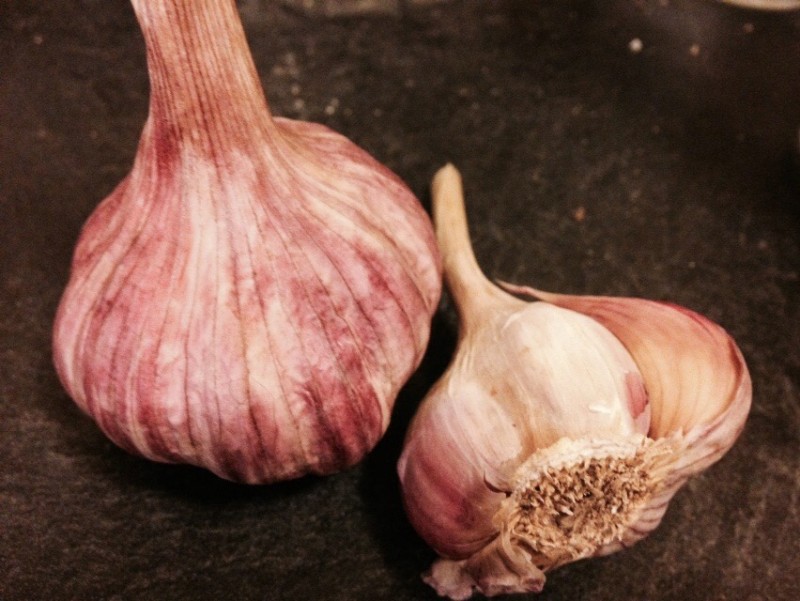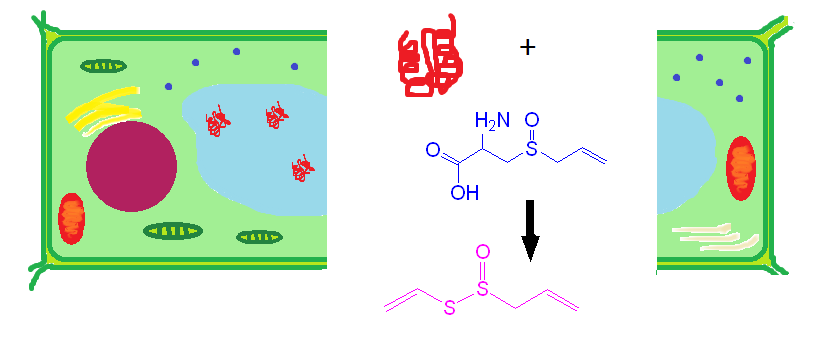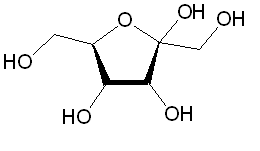
I have loved garlic since I was little. In fact, when I was probably about six, I remember grabbing half of a garlic clove one day, and just shoving it in my mouth. I regretted that decision almost immediately because, not only did I end up with monster garlic breath, but it burned my mouth, throat, and stomach. I felt pretty sick for a few hours.
Since then, I’ve learned how to eat garlic without making myself sick, though I still get garlic breath. And now, I know what leads to the burning sensation of fresh garlic, as well as why garlic is sweet upon slow roasting.
The chemistry of garlic
The most flavorful compounds in garlic contain sulfur—an atom that is known for its pungency (think volcanoes or rotting onions). Although there are many compounds that are responsible for garlic’s flavor, one in particular is responsible for the unpleasant burning sensation in raw garlic. In a plant cell, alliin (dark blue dots) is found in one part of a cell—the cytoplasm, or cell fluids, shown below in light green—and alliinase (red loopy lines) is found in a different part of the plant cell, in structures called vacuoles, shown in light blue. Alliinase is an enzyme, which means it accelerates (or catalyzes) a chemical reaction, and alliinase catalyzes the reaction of alliin breaking apart to allicin. Allicin and aliin are both reactive sulfur molecules
.
Allicin is the one of the molecules that is responsible for the burning sensation, and acts as garlic’s natural pest defense and antimicrobial agent. Other plants in the onion or allium family (onions, leeks, etc.) do contain these molecules, but in lower concentrations than in garlic, which is why they burn less. When a garlic bulb’s plant cells are broken apart, as with cutting, grinding, or chewing, the alliin and the alliinase come into contact with each other and can react. When garlic is cooked before it’s cut, that reaction does not occur, because the heat, in particular, breaks down the enzyme. This also results in a milder garlic flavor. If you do want to use raw garlic without having the intense burning flavor, you can wash the garlic to remove the allicin. This is particularly important if you are preparing the garlic ahead of time because the raw flavor only gets stronger with time.
One of the ways that garlic is a little different from other members of the allium or onion family is how its energy is stored. Garlic contains more long fructose (or fruit sugar) chains than other members of the family. Upon long, slow cooking, those fructose chains break apart into sugar units, resulting in a mellow sweet flavor. This greater percentage of fruit sugars is also responsible for why garlic burns so much more readily than onions.
If you’re really into garlic flavor, don’t refrigerate your garlic, as it leads to a decline in the characteristic garlic flavors. Older, drier garlic also has a more pungent flavor because the flavors are more concentrated. Of course, also chop or mince garlic finely (if not press it) to cause as much allicin formation as possible. If you’re less into garlic, cut it into larger slices or chunks, or even pre-cook it if possible. I was actually in a Penzey’s Spice recently, and I saw that they had roasted garlic powder, which I’m eager to try. If you want to try to make your own roasted garlic, follow my recipe here.
Sources: On Food and Cooking by Harold McGee
https://en.wikipedia.org/wiki/Allicin


